-
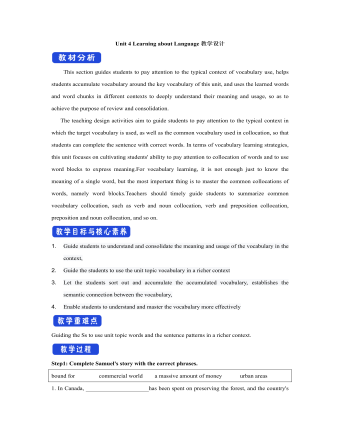
新人教版高中英语选修2Unit 4 Learning about Language教学设计
This section guides students to pay attention to the typical context of vocabulary use, helps students accumulate vocabulary around the key vocabulary of this unit, and uses the learned words and word chunks in different contexts to deeply understand their meaning and usage, so as to achieve the purpose of review and consolidation.The teaching design activities aim to guide students to pay attention to the typical context in which the target vocabulary is used, as well as the common vocabulary used in collocation, so that students can complete the sentence with correct words. In terms of vocabulary learning strategies, this unit focuses on cultivating students' ability to pay attention to collocation of words and to use word blocks to express meaning.For vocabulary learning, it is not enough just to know the meaning of a single word, but the most important thing is to master the common collocations of words, namely word blocks.Teachers should timely guide students to summarize common vocabulary collocation, such as verb and noun collocation, verb and preposition collocation, preposition and noun collocation, and so on.1. Guide students to understand and consolidate the meaning and usage of the vocabulary in the context, 2. Guide the students to use the unit topic vocabulary in a richer context3. Let the students sort out and accumulate the accumulated vocabulary, establishes the semantic connection between the vocabulary,4. Enable students to understand and master the vocabulary more effectivelyGuiding the Ss to use unit topic words and the sentence patterns in a richer context.
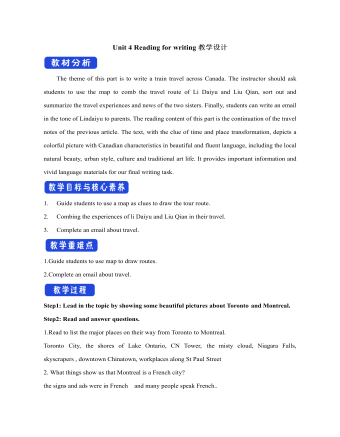
新人教版高中英语选修2Unit 4 Reading for writing教学设计
假定你是英国的Jack,打算来中国旅行,请你给你的中国笔友李华写一封信,要点如下:1.你的旅行计划:北京→泰山→杭州;2.征求建议并询问他是否愿意充当你的导游。注意:1.词数80左右(开头和结尾已给出,不计入总词数);2.可以适当增加细节,以使行文连贯。参考词汇:故宫 the Forbidden City;泰山 Mount TaiDear Li Hua,I'm glad to tell you that 'm going to visit China.First,I am planning to visit Beijing,the capitalof China,where I am looking forward to enjoying the Great Wall,the Forbidden City and somebeautiful parks.Then I intend to go to visit Mount Tai in Shandong Province.I've heard that it is one ofthe most famous mountains in China and I can't wait to enjoy the amazing sunrise there.After that,I amalso going to Hangzhou.It is said that it is a beautiful modern city with breathtaking natural sights,among which the West Lake is a well- known tourist attraction.What do you think of my travel plan? Will you act as my guide? Hope to hear from you soon.

新人教版高中英语选修2Unit 4 Using langauge-Listening教学设计
The theme of the listening section is " talking about scenery and culture along a journey."The part is designed to further lead the students to understand Canadian natural geography and social environment, and integrated into the cultural contrast by mentioning the long train journey from Beijing to Moscow routes. On this basis, the part activates students related travel experience, lets the student serial dialogue, guides the student to explore further the pleasure and meaning of the long journey, and Chinese and foreign cultural comparison.The part also provides a framework for the continuation of the dialogue, which is designed to provide a framework for students to successfully complete their oral expressions, and to incorporate an important trading strategy to end the dialogue naturally.1. Help students to understand and master some common English idioms in the context, and experience the expression effect of English idioms.2. Guide the students to understand the identity of different people in the listening context, and finish the dialogue according to their own experience.3. Instruct the students to use appropriate language to express surprise and curiosity about space and place in the dialogue, and master the oral strategy of ending the dialogue naturally.1. Instruct students to grasp the key information and important details of the dialogue.2. Instruct students to conduct a similar talk on the relevant topic.

新人教版高中英语选修2Unit 5 Learning about Language教学设计
The purpose of this section of vocabulary exercises is to consolidate the key words in the first part of the reading text, let the students write the words according to the English definition, and focus on the detection of the meaning and spelling of the new words. The teaching design includes use English definition to explain words, which is conducive to improving students' interest in vocabulary learning, cultivating their sense of English language and thinking in English, and making students willing to use this method to better grasp the meaning of words, expand their vocabulary, and improve their ability of vocabulary application. Besides, the design offers more context including sentences and short passage for students to practice words flexibly.1. Guide students to understand and consolidate the meaning and usage of the vocabulary in the context, 2. Guide the students to use the unit topic vocabulary in a richer context3. Let the students sort out and accumulate the accumulated vocabulary, establishes the semantic connection between the vocabulary,4. Enable students to understand and master the vocabulary more effectivelyGuiding the Ss to use unit topic words and the sentence patterns in a richer context.Step1: Read the passage about chemical burns and fill in the blanks with the correct forms of the words in the box.
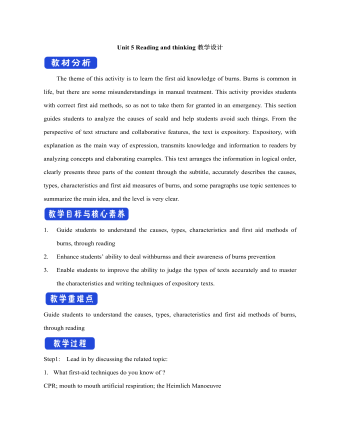
新人教版高中英语选修2Unit 5 Reading and thinking教学设计
The theme of this activity is to learn the first aid knowledge of burns. Burns is common in life, but there are some misunderstandings in manual treatment. This activity provides students with correct first aid methods, so as not to take them for granted in an emergency. This section guides students to analyze the causes of scald and help students avoid such things. From the perspective of text structure and collaborative features, the text is expository. Expository, with explanation as the main way of expression, transmits knowledge and information to readers by analyzing concepts and elaborating examples. This text arranges the information in logical order, clearly presents three parts of the content through the subtitle, accurately describes the causes, types, characteristics and first aid measures of burns, and some paragraphs use topic sentences to summarize the main idea, and the level is very clear.1. Guide students to understand the causes, types, characteristics and first aid methods of burns, through reading2. Enhance students’ ability to deal withburnss and their awareness of burns prevention3. Enable students to improve the ability to judge the types of texts accurately and to master the characteristics and writing techniques of expository texts.Guide students to understand the causes, types, characteristics and first aid methods of burns, through readingStep1: Lead in by discussing the related topic:1. What first-aid techniques do you know of ?CPR; mouth to mouth artificial respiration; the Heimlich Manoeuvre

新人教版高中英语选修2Unit 5 Using langauge-Listening教学设计
The theme of this section is to learn how to make emergency calls. Students should learn how to make emergency calls not only in China, but also in foreign countries in English, so that they can be prepared for future situations outside the home.The emergency telephone number is a vital hotline, which should be the most clear, rapid and effective communication with the acute operator.This section helps students to understand the emergency calls in some countries and the precautions for making emergency calls. Through the study of this section, students can accumulate common expressions and sentence patterns in this context. 1.Help students accumulate emergency telephone numbers in different countries and learn more about first aid2.Guide the students to understand the contents and instructions of the telephone, grasp the characteristics of the emergency telephone and the requirements of the emergency telephone.3.Guide students to understand the first aid instructions of the operators.4.Enable Ss to make simulated emergency calls with their partners in the language they have learned1. Instruct students to grasp the key information and important details of the dialogue.2. Instruct students to conduct a similar talk on the relevant topic.Step1:Look and discuss:Match the pictures below to the medical emergencies, and then discuss the questions in groups.
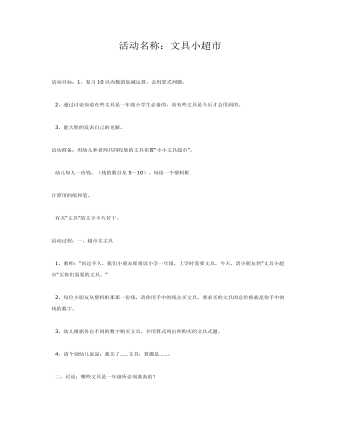
大班数学:文具小超市课件教案
2,通过讨论知道有些文具是一年级小学生必备的,而有些文具是今后才会用到的。 3,能大胆的发表自己的见解。活动准备:用幼儿和老师共同收集的文具布置“小小文具超市”。 幼儿每人一份钱。(钱的数目从5~10)、每组一个塑料框计算用的纸和笔。 有关“文具”的文字卡片若干。
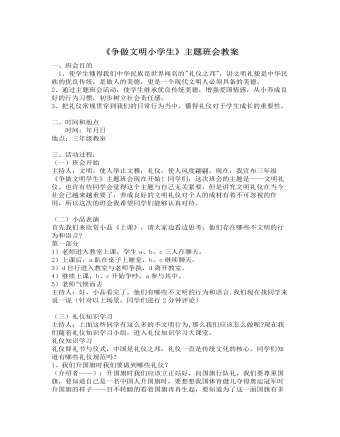
《争做文明小学生》主题班会教案
国旗代表着我们的国家,升国旗是一件神圣而庄严的事,我们不应该当作儿戏,不应该说话打闹而要尊重它、爱护它。2、我们在学校内要做到哪些?学生1:我们作为现代化新人,应该讲究文明礼仪。我个人认为要做到校园文明礼仪有三大点:首先,在学校要尊重老师。在个人方面要做到不打架、不骂人、不吸烟、不喝酒,仪容仪表要符合学校规范。在同学之间要做到互帮互助、团结友爱,创造出一种积极向上良好的范围。3、那我们在公共场合呢?学生2说:不去游戏厅、网吧。学生3:看见垃圾随手拣起来仍到垃圾箱里。不玩危险的游戏。学生4:不去危险的地方玩。学生5:尊老爱幼,不大声喧哗,不随地吐谈。学生6:不浪费水资源,讲卫生。学生7;不吃陌生人的东西,不和陌生人说话。学生8:不在教室里乱跑,不拿别人的东西。
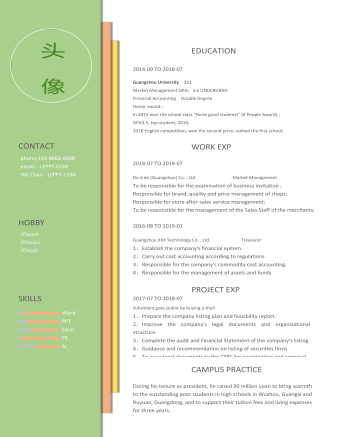
英文简历+中文简历
GuangzhouUniversity 211Market Management GPA:3.6 UNDERGRADFinancial Accounting Double DegreeHonor award::In 2015 won the school class"three good students" (# People Award) ;GPA3.5, top student, 2016;2018 English competition, won thesecond prize, ranked the first school;
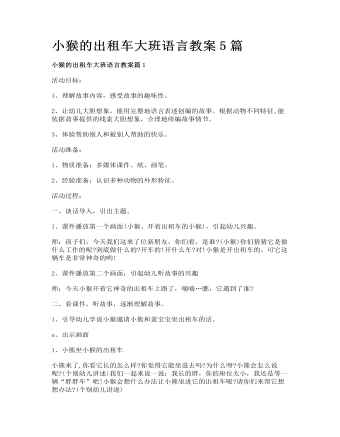
小猴的出租车大班语言教案5篇
1、讲述故事,加深理解。教师操作教具,讲述故事,穿插提问:a小猴发现蛋宝宝和小熊遇到什么困难?如果你是小猴你会怎样解决这个问题?请小朋友积极想办法。b小朋友听故事里的小猴是怎样做的。乘客对小猴设计的出租车是否“满意”(出示字卡满意),为什么?你们喜欢小猴和它的出租车吗?是否也“满意”?2、大胆想象仿编故事。引发仿编兴趣:小猴的名气越来越大了,森林里的小动物都来坐它的出租车。提问:长颈鹿和小刺猬遇到了什么困难?小猴是怎样解决的?森林里还有谁也乘坐小猴的出租车?他们可能遇到什么困难?小猴能解决吗?我们也帮小猴想想让所有的小动物都能顺利的乘坐出租车。(幼儿分组讨论,仿编故事,鼓励幼儿把故事讲给大家听。)
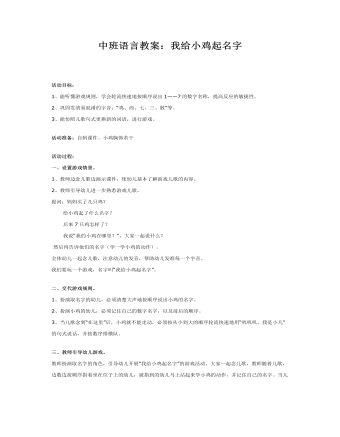
中班语言教案:我给小鸡起名字
活动准备:自制课件、小鸡胸饰若干活动过程:一、设置游戏情景。 1、教师边念儿歌边演示课件,使幼儿基本了解游戏儿歌的内容。 2、教师引导幼儿进一步熟悉游戏儿歌。 提问:妈妈买了几只鸡? 给小鸡起了什么名字? 后来7只鸡怎样了? 我说“我的小鸡在哪里?”,大家一起说什么? 然后再告诉他们的名字(学一学小鸡的动作)。 全体幼儿一起念儿歌,注意幼儿的发音,帮助幼儿发准每一个字音。 我们要玩一个游戏,名字叫“我给小鸡起名字”。二、交代游戏规则。 1、扮演取名字的幼儿,必须清楚大声地按顺序说出小鸡的名字。 2、扮演小鸡的幼儿,必须记住自己的数字名字,以及前后的顺序。 3、当儿歌念到“在这里”后,小鸡就不能走动,必须按从小到大的顺序轮流快速地用“叽叽叽,我是小几”的句式说话,并按数序排横队。

中班语言课件教案:戴眼睛的小猫
1、讲述故事《戴眼镜的小猫》(投影幼儿用书)故事内容:在一座红房子里,住着一位老奶奶和一只小猫。老奶奶年纪大了,每次看报纸时都要戴一副紫色的眼镜,小猫看了很羡慕。(做戴眼镜看报纸状)有一天,老奶奶看完报纸,没来得及把眼镜放好,就被另一位老奶奶叫走了。小猫终于有机会了,它戴着老奶奶的眼镜,高兴地往门口跑,走到大门口,一看,哎呀,门槛怎么变高啦!它用足力气使劲往上跳。只听“咚”的一声,小猫重重地被摔倒在地上。小猫又觉得肚子饿了,想找点东西吃。它刚走到老鼠洞口,就看见对面走来一只很大很大的老鼠。(做肚饿状、大老鼠状)小猫吓得掉头就跑。它边跑边想:这准是一副魔镜,我还是把它给老奶奶放回去吧!小猫悄悄的把眼镜放到了老奶奶的桌上。故事讲完了,好听吗?(好听)我们现在来回忆一下故事讲了什么。(根据幼儿用书上的图画,提问题)——在一座房子里住着谁?(老奶奶和一只小猫)——老奶奶每次看报纸都要戴什么?为什么?(眼镜因为老奶奶年纪大了,眼睛不好)——小猫看见老奶奶戴眼镜很羡慕,有一天它戴上眼镜高兴地跑到大门边,发生了什么?(门槛变高,被重重地摔倒在地上)——小猫肚子饿了,它跑到老鼠洞口又发生了什么?(看见一只很大很大的老鼠,吓得掉头就跑)
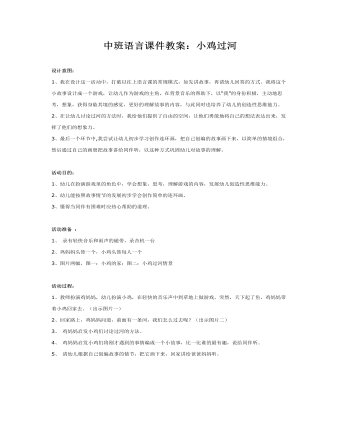
中班语言课件教案:小鸡过河
2、在让幼儿讨论过河的方法时,我给他们提供了自由的空间,让他们勇敢地将自己的想法表达出来,发挥了他们的想象力。 3、最后一个环节中,我尝试让幼儿初步学习创作连环画,把自己创编的故事画下来,以简单的情境组合,然后通过自己的画册把故事讲给同伴听,以这种方式巩固幼儿对故事的理解。活动目的:1、幼儿在扮演游戏里的角色中,学会想象,思考,理解游戏的内容,发展幼儿创造性思维能力。 2、幼儿能按照故事情节的发展初步学会创作简单的连环画。 3、懂得当同伴有困难时应热心帮助的道理。
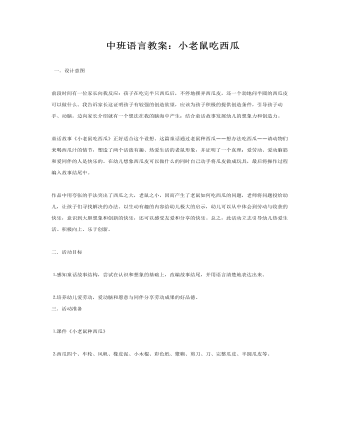
中班语言教案:小老鼠吃西瓜
二.活动目标⒈感知童话故事结构,尝试在认识和想象的基础上,改编故事结尾,并用语言清楚地表达出来。⒉培养幼儿爱劳动,爱动脑和愿意与同伴分享劳动成果的好品德。三.活动准备⒈课件《小老鼠种西瓜》⒉西瓜四个、车轮、风帆、橡皮泥、小木棍、彩色纸、漿糊、剪刀、刀、完整瓜皮、半圆瓜皮等。四.活动过程一、 欣赏故事⒈教师以提问的方法引出故事名称,引起幼儿注意。⒉讲述第一遍故事,边讲边播放 <BR><P></P>课件。(出现大西瓜和小老鼠在屏幕上,突出西瓜大、老鼠小)⒊讲述第二遍故事,边讲述边播放。(动画型式播放故事基本内容)

中班语言课件教案:快乐的小气球
2、实物汽球数只。故事录音磁带1盒,录音机1架。纸(一开大小)1张,笔若干支,颜料(红、绿、蓝、咖啡色)。 活动过程: 一、听故事录音。 1、教师介绍故事名称,提出听故事要求:他细听听故事讲了些会么?帮事里有谁?它们说了些什么话? 2、小朋友听故事。 3、小朋友听完故事后,老师问:故事叫名字?故事里有谁? 二、学讲故事中的对话和短句。 老师运用边讲边画的形式,帮助幼儿理解故事内容,并学讲故事中的对话和短句。 故事第一段--小汽球帮助小鸟。 1、老师边讲边画:天空中飘着几朵白云,风推着云儿慢慢地走,一只小汽球一边唱一边飞来了(出示实物小汽球):“啦啦啦,啦啦啦,我是快乐的小汽球,谁有困难我来帮。”(请幼儿跟学一遍)。 2、老师继续边讲边画:小汽球高兴地往前飞,飞过绿色的草地,飞过高高的树梢,突然听到呜呜的哭声,是谁在哭呀?(出示小鸟)原来草地上有只小鸟在哭。 小汽球连忙问……(请幼儿一起学讲故事中的对话),重点学说短句:“别着急,我来帮助你。” 小汽球就让小鸟骑在自己的背上,带着小鸟一起飞,把小鸟送回了家(演示教具)。
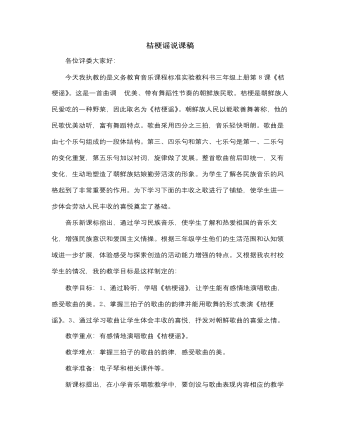
人音版小学音乐三年级上册桔梗谣说课稿
在创编过程中,学生用自主、合作的学习方式来为歌曲创编舞蹈动作,提高了他们的创编能力和表演能力。也进一步让学生感受到歌曲的美,体会到丰收的喜悦心情。最后师生一起舞蹈《桔梗谣》。四、知识拓展最后观看歌舞《丰收的喜悦》。让学生充分体会丰收的喜悦心情,同时增强了学生的民族意识和爱国主义情操。五、让学生说说自己的收获即对这节课进行了小节又紧扣主题。六、板书设计:桔 梗 谣欢乐、 愉悦装饰音七、作业设计:课后把这首歌唱熟练,有兴趣的同学为这首个曲创编更合适的舞蹈动作来为大家表演。我尽可能地将这节唱歌课作到设计合理、有效,让预设的课堂充满魅力。我觉得课上的语言如果在精湛一些会美化整节课,还需要进一步的锻炼。对音乐差生关注的还不是很多。这节课还有很多不足之处,请各位评委老师提出宝贵意见。
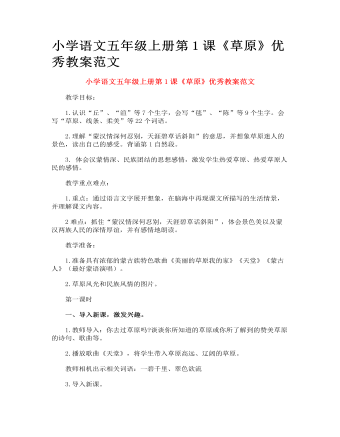
小学语文五年级上册第1课《草原》优秀教案范文
初读课文,学习字词。 1.提出读书要求:默读课文,一边读一边画出不认识的字和不理解的词,并借助词典等学习工具书理解。 2.教师检查学生学习情况。 (1)检查生字读音。 小丘( qiū)渲染(xuàn )迂回( yū)蒙古包( měng ) 襟飘带舞( jīn )鄂温克(è) (2)指导易混淆的字。 “襟”是左右结构,左边是“衤”,与衣服有关,表示衣服胸前的部分。 “涩”是左右结构,右边下面是“止”,不能写成“上”。 “裳”下面是“衣”,与衣服有关。 “微”:中间部分不能少一横。 (3)理解较难的词语。 ①联系上下文理解词语。 草原上行车十分洒脱,只要方向不错,怎么走都可以。 “洒脱”的意思是:潇洒自然,不拘束。这个词语反映了草原的广阔无边。 ②理解“襟飘带舞”一词的意思,可以出示蒙古族鲜艳的服装来分析,意思是:衣襟和裙带随风舞动。 ③“翠色欲流”一词可以从难字入手理解,比如“欲”在这里表示“将要”的意思,“翠色欲流”就是绿得太浓了,将要流下来,写出了草原的绿,是充满生命力的。 ④鄂温克:我国少数民族之一,聚居在内蒙古自治区的东北部。
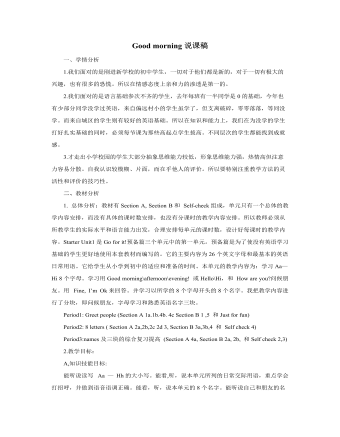
人教版新目标初中英语七年级上册Good morning说课稿
1.课堂活动中的竞赛制:以记奖评优的形式无声的评价每一个活动,包括个体和小群体。在第一课时评最佳演员和导演奖,第二课时评最佳团体奖,既节约时间又明确有效。使学生能提高语言质量,增强参与意识,提高学习兴趣。2. 教师课堂上语言、表情激励制:在课堂活动中教师要乐于 、善于用激励性语言。从good, super, smart, excellent , great ,wonderful等,用微笑,皱眉,摇头、点头等身体语言对于学生的评价是方便又有效的途径。3.课后作业评价:口头作业在第二天课堂上表演,接受全体同学的评价。笔头作业有教师批阅,以评语的方式出现。优秀作业予以展出或交流。积极地肯定和鼓励学生是我们评价的重要目的之一。4.单元结束后综合性评价:除了笔试以外,也可以根据学生实际开展丰富的活动,如:调查报告、小品表演、专题演讲等。

人教版高中英语必修4Body Language说课稿4篇
Textbook: Senior English for China (Book 4), by Liu Daoyi Time Allotment: 1 period (40 minutes)Date: March 20, 2014Teaching aids: blackboard, Multi-media, Power Point, chalk I. Text Analysis (教材分析)This unit is about body language, and the text selected in the reading part demonstrates the difference and similarity of body language in many parts of the world. Through learning this passage, students are required to raise their awareness of using body language in different parts of the world. As body language is closely related to our daily life, it is easy to arouse students’ interest in learning this text. Reading skills and speaking training are designed around the text.II. Teaching Objectives (教学目标)By the end of the lesson, students will be able to:1. Language Skill Objective(语言技能目标): develop reading ability (skimming and scanning)as well as speaking ability.2. Cultural Knowledge Objective(文化知识目标): know about the cultural differences of using body language.3. Affective Objective(情感目标): increase students’ awareness of using body language correctly in different cultures. III.Teaching Focuses and Difficulties(教学重点和难点)1. Teaching Focuses(教学重点): the difference and similarity of body language in many parts of the world.2. Teaching Difficulties(教学难点): develop students’ reading abilities of skimming and scanning and ask the students to show their opinions with fluent English.

人教版高中英语必修1Anne's best friend说课稿
Step 7 Language points 1.Vocabulary (1) go through (2) set down (3) a series of (4) on purpose (5) in order to (6)at dusk (7)entirely (8)face to face 2.Important sentences (1)…I’ve grown so crazy about everything to do with nature. (2)There was a time when … (3)I stayed awake on purpose until … (4)It was the first time … that I’d seen the night … (5)It’s no pleasure looking through … Purpose: 1.Master the required vocabulary and sentence structures. 2.Use them freely. Step 8 Consolidation 1.Find out the topic sentences 2.Retell the text according to the topic sentences Purpose: I want to know if my students understand the text. Step 9 Discussion Imagine you have to go into hiding like Anne and her family, what would you miss most? Giveyour reasons. Purpose: Train Ss’ oral English ability. Step 10 Homework Write an article on Friends. Purpose: 1. Improve the Ss’ writing ability. 2 Train the Ss’ ability of self—teaching and looking up information by themselves. Part 5 Blackboard design(说板书设计)Unit 1 Friendship Reading Anne’s Best Friend 1.Main idea of each paragraph: Para. 1 Anne made her diary her best friend. Para .2 Anne wrote her feelings in her diary. Para .3 Anne missed nature. Para.4 Anne saw the night face to face Para.5 Anne wanted to experience nature outdoors. 2.Listening: Exx.1 P3 3.Discussion: Exx.3 P3 Purpose: 1.Make Ss familiar with the passage 2.Make the design inductive, instructive and artistic.

